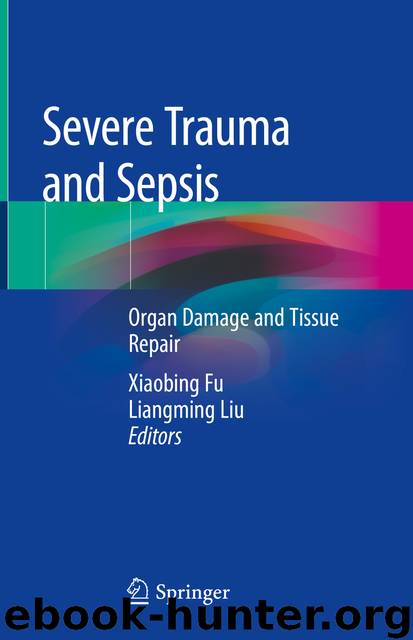Severe Trauma and Sepsis by Xiaobing Fu & Liangming Liu

Author:Xiaobing Fu & Liangming Liu
Language: eng
Format: epub
ISBN: 9789811333538
Publisher: Springer Singapore
12.2.2.2 Regulatory T Cells
Regulatory T cells (Tregs), as one of the T-cell subsets, can be classified into natural Tregs (nTregs), adaptive/induced Tregs (iTregs), type 1 Tregs (Tr1), T helper 3 (Th3), and CD8+Tregs. Forkhead/winged helix transcription factor p3 (Foxp3) is principally found within the CD4+CD25+Treg cell population and plays an important role in the development and functionality of these cells [24]. Tregs are crucial for modulating the immune responses in tumor immunity, transplantation tolerance, as well as infectious diseases. The suppressive function of Tregs is dependent on cell-cell contact mechanism and immunosuppressive cytokines [24]. Cytotoxic T lymphocyte antigen (CTLA)-4 and glucocorticoid-induced tumor necrosis factor receptor (GITR) mediate the function of cell contact-dependent suppression of Tregs [24]. CD25 on the surface of Tregs has high capacity to capture IL-2 which contributes to the suppressive function of the cells. Additionally, transforming growth factor (TGF)-β and interleukin (IL)-10 secreted by Tregs also play a role in immune depression [24].
Clinical studies found that the proportion of CD4+CD25+Treg in the peripheral blood of patients with sepsis is significantly increased [25]. Further studies illustrated that the absolute number of CD4+CD25+Treg cells did not increase significantly, but its immunosuppressive activity was enhanced [26, 27]. The expression of CTLA-4 and Foxp3 and the levels of IL-10 and TGF-β in Treg cells were significantly higher than those in the non-sepsis group [26, 27]. In addition, in patients with sepsis, the immunosuppressive function of Tregs is higher in the death group when compared with that in the survival group [26, 27]. Evidence illustrated DEREG mice depleted of Foxp3+Treg cells before secondary infection with P. aeruginosa 7 days post-CLP had no effects on the course of secondary infection as well as cytokine levels [28]. Nevertheless, our study found partial depletion of CD25+Tregs by PC61 treatment 3 days post-CLP also enhanced host immune responses against secondary acute P. aeruginosa and improved the outcomes of the disease (unpublished data). The difference in the results might be explained on the basis of experimental techniques including septic models and the depletion strategies of Tregs. The exact role of Treg in secondary infection post-sepsis remains to be investigated.
Download
This site does not store any files on its server. We only index and link to content provided by other sites. Please contact the content providers to delete copyright contents if any and email us, we'll remove relevant links or contents immediately.
| Administration & Medicine Economics | Allied Health Professions |
| Basic Sciences | Dentistry |
| History | Medical Informatics |
| Medicine | Nursing |
| Pharmacology | Psychology |
| Research | Veterinary Medicine |
When Breath Becomes Air by Paul Kalanithi(7256)
Why We Sleep: Unlocking the Power of Sleep and Dreams by Matthew Walker(5637)
Paper Towns by Green John(4165)
The Immortal Life of Henrietta Lacks by Rebecca Skloot(3821)
The Sports Rules Book by Human Kinetics(3582)
Dynamic Alignment Through Imagery by Eric Franklin(3483)
ACSM's Complete Guide to Fitness & Health by ACSM(3462)
Kaplan MCAT Organic Chemistry Review: Created for MCAT 2015 (Kaplan Test Prep) by Kaplan(3419)
Introduction to Kinesiology by Shirl J. Hoffman(3297)
Livewired by David Eagleman(3117)
The River of Consciousness by Oliver Sacks(2989)
Alchemy and Alchemists by C. J. S. Thompson(2909)
The Death of the Heart by Elizabeth Bowen(2897)
Descartes' Error by Antonio Damasio(2728)
Bad Pharma by Ben Goldacre(2724)
The Gene: An Intimate History by Siddhartha Mukherjee(2489)
Kaplan MCAT Behavioral Sciences Review: Created for MCAT 2015 (Kaplan Test Prep) by Kaplan(2487)
The Fate of Rome: Climate, Disease, and the End of an Empire (The Princeton History of the Ancient World) by Kyle Harper(2431)
The Emperor of All Maladies: A Biography of Cancer by Siddhartha Mukherjee(2427)
